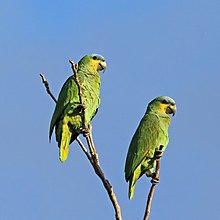The orange-winged amazon (Amazona amazonica), also known locally as orange-winged parrot and loro guaro, is a large amazon parrot. It is a resident breeding bird in tropical South America, from Colombia, Trinidad and Tobago south to Peru, Bolivia and central Brazil. Its habitat is forest and semi-open country. Although common, it is persecuted as an agricultural pest and by capture for the pet trade (over 66,000 captured from 1981 to 1985). It is also hunted as a food source. Introduced breeding populations have been reported in Puerto Rico[2] and Tenerife in the Canary Islands.[3]
| Orange-winged amazon | |
|---|---|

| |
| A. a. amazonica, Ecuador | |

| |
| A. a. tobagensis, Tobago | |
| Scientific classification | |
| Domain: | Eukaryota |
| Kingdom: | Animalia |
| Phylum: | Chordata |
| Class: | Aves |
| Order: | Psittaciformes |
| Family: | Psittacidae |
| Genus: | Amazona |
| Species: | A. amazonica
|
| Binomial name | |
| Amazona amazonica (Linnaeus, 1766)
| |

| |
| Synonyms | |
|
Psittacus amazonicus Linnaeus, 1766 | |
Taxonomy
editThe orange-winged amazon was formally described in 1766 by the Swedish naturalist Carl Linnaeus in the twelfth edition of his Systema Naturae He placed it with all the other parrots in the genus Psittacus and coined the binomial name Psittacus amazonicus.[4] Linnaeus cited the 1760 description by the French zoologist Mathurin Jacques Brisson. Brisson used the French name "Le Perroquet Amazone" and the Latin name later used by Linnaeus, Psittacus amazonicus.[5] Although Brisson coined Latin names, these do not conform to the binomial system and are not recognised by the International Commission on Zoological Nomenclature.[6] The orange-winged amazon is now one of around 30 species placed in the genus Amazona that was introduced by the French naturalist René Lesson in 1830.[7][8] The species is considered to be monotypic: no subspecies are recognised.[8]
Description
editThe orange-winged amazon is a mainly green parrot about 33 cm (13 in) long and weighing about 340 g. It has blue and yellow feathers on its head which varies in extent between individuals. The upper mandible is partly horn colored (gray) and partly dark-gray. It has orange feathers in the wings and tail, which can be seen when in flight. The male and female are identical in external appearance.[9]
Behavior
editDiet and feeding
editThe orange-winged amazons are noisy birds and makes loud, high-pitched screams. It eats fruit, seeds, nuts, blossoms, leaf buds, and berries,[10] including the fruit of palm trees and sometimes cocoa, mangoes, and oranges.[10] It roosts communally in palm and other trees, and large numbers can be seen at the roost sites at dawn and dusk. It is becoming common as a feral bird in the Miami, Florida area, and there are colonies in London, England.
Breeding
editThe orange-winged amazon nests in tree cavities. The eggs are white and there are usually three or four in a clutch. The female incubates the eggs for about 26 days and the chicks leave the nest about 60 days after hatching.[9]
The orange-winged amazon has been introduced to Tenerife in the Canary Islands, where it has been observed successfully hybridizing with a feral scaly-headed parrot (Pionus maximiliani) and also attempting to breed with feral monk parakeet (Myiopsitta monachus) and rose-ringed parakeet (Psittacula krameri), even involving itself in the former species' unusual nest-building behaviour.[3]
References
edit- ^ BirdLife International (2018). "Amazona amazonica". IUCN Red List of Threatened Species. 2018: e.T22686350A131920257. doi:10.2305/IUCN.UK.2018-2.RLTS.T22686350A131920257.en. Retrieved 19 November 2021.
- ^ Falcón, Wilfredo; Tremblay, Raymond L. (2018). "From the cage to the wild: introductions of Psittaciformes to Puerto Rico". PeerJ. 6: e5669. doi:10.7717/peerj.5669. PMC 6214232. PMID 30397538.
- ^ a b Hernández-Brito, Dailos (18 March 2021). "Mate shortage in exotic parrots". British Ornithologists' Union. doi:10.1111/ibi.12936. S2CID 233929115. Retrieved 19 March 2021.
- ^ Gmelin, Johann Friedrich (1788). Systema naturae per regna tria naturae : secundum classes, ordines, genera, species, cum characteribus, differentiis, synonymis, locis (in Latin). Vol. 1, Part 1 (13th ed.). Lipsiae [Leipzig]: Georg. Emanuel. Beer. p. 147.
- ^ Brisson, Mathurin Jacques (1760). Ornithologie, ou, Méthode Contenant la Division des Oiseaux en Ordres, Sections, Genres, Especes & leurs Variétés (in French and Latin). Vol. 4. Paris: Jean-Baptiste Bauche. p. 256-261. The two stars (**) at the start of the section indicates that Brisson based his description on the examination of a specimen.
- ^ Allen, J.A. (1910). "Collation of Brisson's genera of birds with those of Linnaeus". Bulletin of the American Museum of Natural History. 28: 317–335. hdl:2246/678.
- ^ Lesson, René (1831). Traité d'Ornithologie, ou Tableau Méthodique (in French). Vol. 1. Paris: F.G. Levrault. p. 189.
- ^ a b Gill, Frank; Donsker, David; Rasmussen, Pamela, eds. (January 2022). "Parrots, cockatoos". IOC World Bird List Version 12.1. International Ornithologists' Union. Retrieved 20 March 2022.
- ^ a b Alderton, David (2003). The Ultimate Encyclopedia of Caged and Aviary Birds. London, England: Hermes House. p. 231. ISBN 1-84309-164-X.
- ^ a b "Amazona amazonica (Orange-winged Parrot)" (PDF). Sta.uwi.edu. Retrieved 24 March 2022.
Further reading
edit- Birds of Venezuela by Hilty, ISBN 0-7136-6418-5.
- ffrench, Richard (1991). A Guide to the Birds of Trinidad and Tobago (2nd ed.). Comstock Publishing. ISBN 0-8014-9792-2.
- "National Geographic" Field Guide to the Birds of North America ISBN 0-7922-6877-6.
- Handbook of the Birds of the World Vol 4, Josep del Hoyo editor, ISBN 84-87334-22-9.
- "National Audubon Society" The Sibley Guide to Birds, by David Allen Sibley, ISBN 0-679-45122-6.
External links
editMedia related to Amazona amazonica at Wikimedia Commons
- "Amazon Parrots" - Faze magazine
